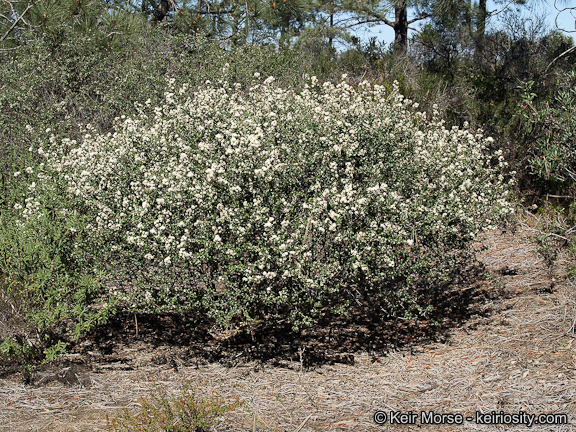Current Distribution Rangewide
Riverside County, San Diego County, and northern Baja California, Mexico [1].
Known Populations in San Diego County
Twenty-two occurrences on Conserved Lands in Mus 1 (Cabrillo National Monument, Tijuana River Valley Regional Park), 2 (Florida Canyon, 34th Street Canyon, Manzanita Canyon, Soledad Natural Park), 6 (Bernardo Mountain, Carmel Mountain Preserve, Del Dios Highland Open Space Preserve, Elfin Forest Recreational Preserve, Hodges Reservoir Open Space, Oakcrest Park, Rancho La Costa Habitat Conservation Area, Torrey Pines State Natural Reserve), and 7 (City of Encinitas Open Space, Crest Canyon Preserve, Torrey Pines State Natural Reserve).
List Status
None [1].
Habitat Affinities
Rocky slopes, chaparral [2], and coastal scrub [3]. Elevation range is 1-380 meters [1].
Taxonomy and Genetics
Rhamnaceae family [1].
Life History Demography
Perennial evergreen shrub [1]. Long-lived obligate seeder [3]. Killed by fire, but dependent on it for stand reestablishment.
Seasonal Phenology
Bloom period December-May [1].
Pollination Seed Dispersal
Primarily an obligate seeder with rare vegetative establishment [4]. Seed production begins at 3-6 years [3, 4, 5]. Peak production is estimated at 300 seeds per plant [3]. Long-lived persistent seedbank [4]. Seeds initially dispersed about 1 meter from plant ballistically [6; cited in 3] and secondarily by animal vectors such as harvester ants, small mammals and birds [7, 8; both cited in 3].
Threats
Fire-dependent episodic reproduction increases vulnerability to climate change in two ways: 1) changes in timing and intensity of fires and 2) precipitation changes affecting post-fire reproduction [4]. Obligate seeders face 2 fire-related risks: 1) seed bank depletion occurring with very long fire intervals and 2) immaturity risk with fires occurring before seedbank is built. Habitat fragmentation due to coastal development. Shortened fire return interval due to human-caused ignitions.
Special Considerations:
Herbivory and drought drive mortality in the first 2 years [8; cited in 3, 9, 10]. Habitat suitability under projected future climate scenarios was determined using Maxent in a 2011 study by Dawn Lawson [3]. Results from the Bonebrake et al. study determined that managed relocation of seeds is an effective management alternative to reduce population decline resulting from land-use and climate change [11]. SDMs from this study predicted future habitat patches only beyond the current known distribution, leaving managed relocation the only type of translocating available. These patches are not on conserved lands, and with the current legal conservation status of C. verrucosus, managed relocation would be challenging.
Literature Sources
[1] CNPS, Rare Plant Program. 2016. Inventory of Rare and Endangered Plants (online edition, v8-02). California Native Plant Society, Sacramento, CA. http://www.rareplants.cnps.org, accessed 05 September 2016.
[2] Wilken, D.H. 2016. Ceanothus verrucosus, in Jepson Flora Project (eds.) Jepson eFlora, http://ucjeps.berkeley.edu/cgi-bin/get_IJM.pl?tid=18506, accessed on September 05, 2016.
[3] Lawson, D. M. 2011. “Examination of Habitat Fragmentation and Effects on Species Persistence in the Vicinity of Naval Base Pt. Loma and Marine Corps Air Station Miramar, San Diego, CA and Development of a Multi-Species Planning Framework for Fragmented Landscapes.â€
[4] Lawson, D. M., H. M. Regan, P. H. Zedler, and J. Franklin. 2010. “Cumulative Effects of Land Use, Altered Fire Regime and Climate Change on Persistence of Ceanothus Verrucosus, a Rare, Fire-Dependent Plant Species.†Global Change Biology 16 (9): 2518–29. doi:10.1111/j.1365-2486.2009.02143.x.
[5] Zammit, C.A., and P.H. Zedler. 1993. “Size Structure and Seed Production in Even-Aged Populations of Ceanothus Greggii in Mixed Chaparral.†Journal of Ecology 81: 499–511.
[6] Quinn, R. n.d. “Unpublished Results.â€
[7] Davey, J.R. 1982. “Stand Replacement in Ceanothus Crassifolius.†California Polytechnic University, Pamona.
[8] Quinn, R. D. 1994. “Animals, Fire, and Vertebrate Herbivory in Californian Chaparral and Other Mediterranean-Type Ecosystems.†In Ecological Studies, edited by Jose M. Moreno and C. Oechel, Walter, 107:46–78. New York, NY: Springer.
[9] Kummerow, J., B. A. Ellis, and J. N. Mills. 1985. “Post-Fire Seedling Establishment of Adenostoma Fasciculatum and Ceanothus Greggii in Southern California Chaparral.†Madroño 32 (3): 148–57.
[10] Moreno, J. M., and W. C. Oechel. 1991. “Fire Intensity and Herbivory Effects on Postfire Resprouting of Adenostoma Fasciculatum in Southern California Chaparral.†Oecologia 85 (3): 429–33. doi:10.1007/BF00320621.
[11] Bonebrake, Timothy C., Alexandra D. Syphard, Janet Franklin, Kurt E. Anderson, H. Resit Akçakaya, Toni Mizerek, Clark Winchell, and Helen M. Regan. 2014. “Fire Management, Managed Relocation, and Land Conservation Options for Long-Lived Obligate Seeding Plants under Global Changes in Climate, Urbanization, and Fire Regime.†Conservation Biology 28 (4): 1057–67. doi:10.1111/cobi.12253.


